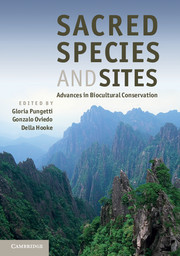Book contents
- Frontmatter
- Contents
- List of Contributors
- Foreword
- Preface
- Acknowledgements
- Introduction
- Part I Concepts and Knowledge
- Part II Sacred Landscapes
- Part III Sacred Sites and People
- 9 The landscape in the cosmoscape, and sacred sites and species among the Tanimuka and Yukuna Amerindian tribes (north-west Amazon)
- 10 Sacred natural sites in zones of armed conflicts: the Sierra Nevada de Santa Marta in Colombia
- 11 Struggles to protect Puketapu, a sacred hill in Aotearoa
- 12 The Roman goddess Care: a therapy for the planet
- Part IV Sacred Species
- Part V Sacred Animals
- Part VI Sacred Groves and Plants
- Part VII Implementation and Conclusions
- Index
- Plate Section
- References
10 - Sacred natural sites in zones of armed conflicts: the Sierra Nevada de Santa Marta in Colombia
from Part III - Sacred Sites and People
Published online by Cambridge University Press: 05 August 2012
- Frontmatter
- Contents
- List of Contributors
- Foreword
- Preface
- Acknowledgements
- Introduction
- Part I Concepts and Knowledge
- Part II Sacred Landscapes
- Part III Sacred Sites and People
- 9 The landscape in the cosmoscape, and sacred sites and species among the Tanimuka and Yukuna Amerindian tribes (north-west Amazon)
- 10 Sacred natural sites in zones of armed conflicts: the Sierra Nevada de Santa Marta in Colombia
- 11 Struggles to protect Puketapu, a sacred hill in Aotearoa
- 12 The Roman goddess Care: a therapy for the planet
- Part IV Sacred Species
- Part V Sacred Animals
- Part VI Sacred Groves and Plants
- Part VII Implementation and Conclusions
- Index
- Plate Section
- References
Summary
Introduction
The Sierra Nevada de Santa Marta population includes some 32 000 members of the Kogi, Arhuaco, Wiwa and Kankuamo indigenous groups, descendants of the Tayronas and preservers of their ancient tradition. There are also approximately 150 000 peasants, and 1.5 million urban dwellers in the lowlands. Of these, the only stable populations are the indigenous groups and although each group has its own language, they all share a similar system of beliefs. Since pre-Hispanic times, the indigenous peoples of the Sierra Nevada have possessed a worldview, social organisation and living pattern which revolves around the management and conservation of this unique environment, the ‘heart of the world’ (Reichel-Dolmatoff, 1950, pp. 1–32).
Indigenous people believe that between man and nature there is an equilibrium, which can easily be disturbed by irresponsible human actions. This equilibrium not only refers to the management of resources, but also to the spiritual and moral balance of the individual and the group that is the basic element of peace (Arhem, 1990, pp. 105–22).
The Sierra Nevada de Santa Marta
Colombia presents perhaps the best opportunity and the greatest challenge for the conservation of biological and cultural diversity in our hemisphere. This South American country is recognised as the nation with the greatest biological wealth per square mile and the largest number of languages. Amidst this wealth lies a national treasure: the Sierra Nevada de Santa Marta.
- Type
- Chapter
- Information
- Sacred Species and SitesAdvances in Biocultural Conservation, pp. 152 - 164Publisher: Cambridge University PressPrint publication year: 2012
References
- 1
- Cited by



